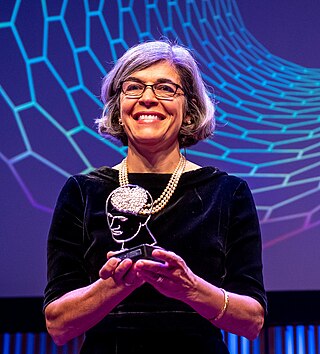Related Research Articles

Magnetic resonance imaging (MRI) is a medical imaging technique used in radiology to form pictures of the anatomy and the physiological processes of the body. MRI scanners use strong magnetic fields, magnetic field gradients, and radio waves to generate images of the organs in the body. MRI does not involve X-rays or the use of ionizing radiation, which distinguishes it from computed tomography (CT) and positron emission tomography (PET) scans. MRI is a medical application of nuclear magnetic resonance (NMR) which can also be used for imaging in other NMR applications, such as NMR spectroscopy.

Neurology is the branch of medicine dealing with the diagnosis and treatment of all categories of conditions and disease involving the nervous system, which comprises the brain, the spinal cord and the peripheral nerves. Neurological practice relies heavily on the field of neuroscience, the scientific study of the nervous system.

Medical cannabis, or medical marijuana (MMJ), is cannabis and cannabinoids that are prescribed by physicians for their patients. The use of cannabis as medicine has not been rigorously tested due to production and governmental restrictions, resulting in limited clinical research to define the safety and efficacy of using cannabis to treat diseases.
Neuroimaging is a medical technique that allows doctors and researchers to take pictures of the inner workings of the body or brain of a patient. It can show areas with heightened activity, areas with high or low blood flow, the structure of the patients brain/body, as well as certain abnormalities. Neuroimaging is most often used to find the specific location of certain diseases or birth defects such as tumors, cancers, or clogged arteries. Neuroimaging first came about as a medical technique in the 1880's with the invention of the human circulation balance and has since lead to other inventions such as the x-ray, air ventriculography, cerebral angiography, PET/SPECT scans, magnetoencephalography, and xenon CT scanning.

Neuroimaging is the use of quantitative (computational) techniques to study the structure and function of the central nervous system, developed as an objective way of scientifically studying the healthy human brain in a non-invasive manner. Increasingly it is also being used for quantitative research studies of brain disease and psychiatric illness. Neuroimaging is highly multidisciplinary involving neuroscience, computer science, psychology and statistics, and is not a medical specialty. Neuroimaging is sometimes confused with neuroradiology.
Psychiatric epidemiology is a field which studies the causes (etiology) of mental disorders in society, as well as conceptualization and prevalence of mental illness. It is a subfield of the more general epidemiology. It has roots in sociological studies of the early 20th century. However, while sociological exposures are still widely studied in psychiatric epidemiology, the field has since expanded to the study of a wide area of environmental risk factors, such as major life events, as well as genetic exposures. Increasingly neuroscientific techniques like MRI are used to explore the mechanisms behind how exposures to risk factors may impact psychological problems and explore the neuroanatomical substrate underlying psychiatric disorders.

The Wellcome Centre for Human Neuroimaging at University College London is a world-leading interdisciplinary centre for neuroimaging research based in London, United Kingdom. Researchers at the Centre use expertise to investigate how the human brain generates behaviour, thoughts and feelings and how to use this knowledge to help patients with neurological and psychiatric disorders. Human neuroimaging allows scientists to non-invasively investigate the brain structure and functions including Action, Decision Making, Emotion, Hearing, Language, Memory, Navigation, Seeing, Self awareness, Social Behaviour and the Bayesian Brain

Anna Christina Nobre FBA, MAE, fNASc is a Brazilian and British cognitive neuroscientist working at Yale University in New Haven, CT, USA.

The long-term effects of cannabis have been the subject of ongoing debate. Because cannabis is illegal in most countries, clinical research presents a challenge and there is limited evidence from which to draw conclusions. In 2017, the U.S. National Academies of Sciences, Engineering, and Medicine issued a report summarizing much of the published literature on health effects of cannabis, into categories regarded as conclusive, substantial, moderate, limited and of no or insufficient evidence to support an association with a particular outcome.
The Athinoula A. Martinos Center for Biomedical Imaging, usually referred to as just the "Martinos Center," is a major hub of biomedical imaging technology development and translational research. The Center is part of the Department of Radiology at Massachusetts General Hospital and is affiliated with both Harvard University and MIT. Bruce Rosen is the Director of the Center and Monica Langone is the Administrative Director.
Anders Martin Dale is a prominent neuroscientist and professor of radiology, neurosciences, psychiatry, and cognitive science at the University of California, San Diego (UCSD), and is one of the world's leading developers of sophisticated computational neuroimaging techniques. He is the founding Director of the Center for Multimodal Imaging Genetics (CMIG) at UCSD.
Mark Steven Cohen is an American neuroscientist and early pioneer of functional brain imaging using magnetic resonance imaging. He currently is a Professor of Psychiatry, Neurology, Radiology, Psychology, Biomedical Physics and Biomedical Engineering at the Semel Institute for Neuroscience and Human Behavior and the Staglin Center for Cognitive Neuroscience. He is also a performing musician.
Arno Villringer is a Director at the Department of Neurology at the Max Planck Institute for Human Cognitive and Brain Sciences in Leipzig, Germany; Director of the Department of Cognitive Neurology at University of Leipzig Medical Center; and Academic Director of the Berlin School of Mind and Brain and the Mind&Brain Institute, Berlin. He holds a full professorship at University of Leipzig and an honorary professorship at Charité, Humboldt-Universität zu Berlin. From July 2022 to June 2025 he is the Chairperson of the Human Sciences Section of the Max Planck Society.
Schizophrenia is a primary psychotic disorder, whereas, bipolar disorder is a primary mood disorder which can also involve psychosis. Both schizophrenia and bipolar disorder are characterized as critical psychiatric disorders in the Diagnostic and Statistical Manual of Mental Disorders fifth edition (DSM-5). However, because of some similar symptoms, differentiating between the two can sometimes be difficult; indeed, there is an intermediate diagnosis termed schizoaffective disorder.

Resting state fMRI is a method of functional magnetic resonance imaging (fMRI) that is used in brain mapping to evaluate regional interactions that occur in a resting or task-negative state, when an explicit task is not being performed. A number of resting-state brain networks have been identified, one of which is the default mode network. These brain networks are observed through changes in blood flow in the brain which creates what is referred to as a blood-oxygen-level dependent (BOLD) signal that can be measured using fMRI.
The following outline is provided as an overview of and topical guide to brain mapping:
Bruce Rosen is an American physicist and radiologist and a leading expert in the area of functional neuroimaging. His research for the past 30 years has focused on the development and application of physiological and functional nuclear magnetic resonance techniques, as well as new approaches to combine functional magnetic resonance imaging (fMRI) data with information from other modalities such as positron emission tomography (PET), magnetoencephalography (MEG) and noninvasive optical imaging. The techniques his group has developed to measure physiological and metabolic changes associated with brain activation and cerebrovascular insult are used by research centers and hospitals throughout the world.

Prof. Dr. med. Wolfgang Grodd is a German neuroradiologist and professor emeritus of the University hospital at the University of Tübingen. He is known for his scientific works on the development and application of structural and functional magnetic resonance imaging in metabolic diseases, sensorimotor representation, language production, and cognitive processing, cerebellum, thalamus, and basal ganglia. Currently, Wolfgang Grodd is a research scientist at the Department of the High-Field MR at the Max Planck Institute for Biological Cybernetics.
Anthony Feinstein is a professor of psychiatry at the University of Toronto and a neuropsychiatrist. His research and clinical work focuses on people with multiple sclerosis, traumatic brain injury and Conversion Disorder. He has undertaken a number of studies investigating how front-line journalists are affected by their work covering war and man-made and natural disasters.
Sharlene D. Newman is an American cognitive neuroscientist, executive director of the Alabama Life Research Institute at the University of Alabama (UA), Professor in the Department of Psychology at UA, and an adjunct professor in the Department of Psychological and Brain Sciences at Indiana University.
References
- 1 2 "Staci Gruber, PhD | McLean Hospital". www.mcleanhospital.org. Retrieved 2022-06-16.
- ↑ Gruber, Staci Ann (2002). Stroop performance in schizophrenic and bipolar patients: an fMRI study (Thesis). OCLC 190834435.
- 1 2 Jennifer Walter (February 7, 2020). "What Science Knows About Marijuana's Health Benefits". Discover Magazine .
- ↑ "Gift Funds Neuroscience Research into Medical Marijuana". Harvard Magazine. 8 October 2014. Retrieved 3 October 2022.
- ↑ "Largest Grant Ever for Cannabis Research to Help Fund Study by McLean's Dr. Staci Gruber". McLean Hospital. 2 May 2020. Retrieved 3 October 2022.
- ↑ Renshaw, PF; Yurgelun-Todd, DA; Gruber, S; Cohen, BM (1995). "emporal lobe proton magnetic resonance spectroscopy of patients with first episode psychosis". American Journal of Psychiatry. 152 (3): 444–446. doi:10.1176/ajp.152.3.444. PMID 7864274.
- ↑ Yurgelun-Todd, DA; Waternaux, CM; Cohen, BM; Gruber, SA; English, CD; Renshaw, PF (1996). "Functional magnetic resonance imaging of schizophrenic patients and comparison subjects during word production". American Journal of Psychiatry. 153 (2): 200–205. doi:10.1176/ajp.153.2.200. PMID 8561199.
- ↑ Gruber, Staci A.; Sagar, Kelly A.; Dahlgren, Mary Kathryn; Racine, Megan; Lukas, Scott E. (2012). "Age of Onset of Marijuana Use and Executive Function". Psychology of Addictive Behaviors. 26 (3): 496–506. doi:10.1037/a0026269. PMC 3345171 . PMID 22103843.
- ↑ "McLean Hospital and Harvard Medical School Researchers to Conduct Revolutionary Study on Medical Marijuana and the Brain". McLean Hospital. 6 October 2014. Retrieved 11 October 2022.
- ↑ "Uncovering the Mysteries of Marijuana". McLean Hospital. 27 April 2016. Retrieved 11 October 2022.
- ↑ "Women's Health Initiative at MIND". drstacigruber.com.
- ↑ Alvin Powell (February 3, 2017), "Playing catch-up on marijuana – The preliminary results of legal medical and recreational marijuana use are encouraging says Medical School Associate Professor Staci Gruber, but more research should be done before any more legislation is written.", The Harvard Gazette , Harvard University
- 1 2 Leah Samuel (August 17, 2016). "This is your brain on pot: Neuroscientist studies long-term effects of medical marijuana". The Boston Globe.
- ↑ Tess C. Kelley (March 11, 2021). "Decoding Cannabis". Harvard Crimson .
- ↑ Andrea Sparr-Jaswa (October 25, 2019). "Senate Committee Hearing Emphasizes the Need for Policy Change to Increase Cannabis Research Access". Cannabis Business Times.
- ↑ Natalie Fertig (March 11, 2021), "New cannabis coalition wants to influence how — not if — weed is legalized", Politico
- ↑ "Testimony of Dr. Staci Gruber, "Marijuana and America's Health: Questions and Issues for Policy Makers"" (PDF), United States Congress official website, United States Senate Caucus on International Narcotics Control, October 23, 2019
- ↑ "Crime pays quite well for Patricia Cornwell" USA Today December 3, 2008
- ↑ "Patricia Cornwell: 'Finally, I feel rooted somewhere'" November 26, 2007